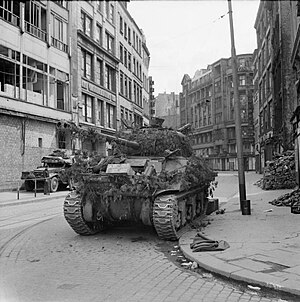Battle of Hamburg (1945)
| Battle of Hamburg | |||||||
|---|---|---|---|---|---|---|---|
| Part of the Invasion of Germany during World War II | |||||||
 A British tank in the city centre after the battle. |
|||||||
|
|||||||
| Belligerents | |||||||
|
|
|
||||||
| Commanders and leaders | |||||||
|
|
|
||||||
| Units involved | |||||||
|
VIII Corps XII Corps (elements) |
1st Parachute Army (elements) | ||||||
| Strength | |||||||
| 3 Divisions ~10,000 troops |
2 Divisions (Understrength) ~3,000 troops |
||||||
| Casualties and losses | |||||||
| Heavy | |||||||
The Battle of Hamburg was one of the last battles of World War II, where the remaining troops of the German 1st Parachute Army fought the British VIII Corps for the control of Hamburg, between 18 April and 3 May 1945. British troops were met with fierce resistance inside the city as Hamburg was the last significant remaining pocket of resistance in the north. Once the British had captured the city, they continued their advance north-east and sealed off the remnants of the 1st Parachute Army and Army Group Northwest in the Jutland peninsula.
After the Western Allies crossed the River Rhine, the German armies in the west began to fall apart. Army Group B, under the command of Walter Model, was the last effective German defence in the west. However the Army Group, consisting of three armies, were encircled and captured by the 1st and 9th American Armies, thus ending effective German resistance in the west. After the defeat of Army Group B, the Germans were only able to organize resistance in a few cities and were not able to communicate with each other very well. The Allied armies started a general advance across Germany, with the Americans pushing the centre and the British holding their northern flank. The main British thrust came from the British Second Army, under the command of Lieutenant General Miles C. Dempsey. The army's objective was to advance across northern Germany and push on to Berlin. The British came across little resistance, compared with the Americans further south, and advanced at a steady and fast pace. The 1st Parachute Army and the newly-formed Army Group Northwest were the last German forces in the north. As the British continued their advance, the German high command in Berlin, which was under siege by the Soviet Red Army, refused to send reinforcements. The Germans managed to resist the British in Bremen for a week; the surviving troops retreated to the Jutland peninsula. The last remaining defence was the city of Hamburg and the Germans sought to make a final stand there. After capturing Soltau, the British 7th Armoured Division of the VIII Corps was poised to assault the city.
...
Wikipedia
